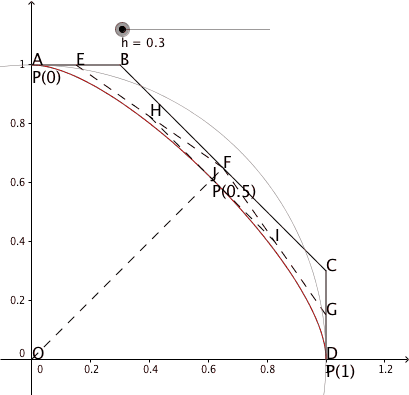三阶贝塞尔曲线拟合1/4圆
根据贝塞尔曲线的知识,我们知道三阶贝塞尔曲线的参数方程如下,其中A、B、C、D为四个控制点坐标,P(t)表示曲线上的每一点。
因为要模拟1/4圆,所以通过P(0)和P(1)的切线方向,应该按照下图所示位置安放。
其中AB为水平方向,DC为垂直方向,并且线段长度|AB| = |DC| = h。
那么这个问题实际上,就转换为计算出合理的h值,使得半径|OJ| = 1,也即J点刚好在圆弧上。
根据贝塞尔曲线的对称性,不难想出J点在P(0.5)处,代入公式即可求得:
同样的结论,也可以直接由贝塞尔曲线的几何图形特征来推定,也即:
所以也可以再次确认P(0.5)和J是同一点。
代入四个控制点坐标A(0, 1),B(h, 1),C(1, h)和D(1, 0),可以求解P(0.5)点坐标如下:
根据圆形方程定义,可以拟出下面方程:
从而求解出h的值为:
所以,可以最终求解出三阶贝塞尔曲线模拟1/4圆的参数方程P(t)定义如下:
另一方面,该方程描述的曲线与真实1/4圆有多大差异呢?下面就针对这个问题进行数值求解。
采用t = 0.0到1.0,步进值0.01,求解每个点到原点的距离与半径1的差异。
#include <stdio.h>
#include <stdlib.h>
#include <string.h>
#include <math.h>
double bezier3(double a, double b, double c, double d, double t)
{
double nt = 1.0 - t;
double nt2 = nt * nt;
double nt3 = nt * nt * nt;
double t2 = t * t;
double t3 = t * t * t;
return (a * nt3 + b * 3.0 * nt2 * t + c * 3.0 * nt * t2 + d * t3);
}
int main()
{
double t, a;
double d, e;
double max_e = 0.0, min_e = 1.0;
double x, y;
double h = (sqrt(2) - 1.0) * 4.0 / 3.0;
for(t = 0.0; t < 1.01; t+=0.01)
{
x = bezier3(0, h, 1, 1, t);
y = bezier3(1, 1, h, 0, t);
d = sqrt(x * x + y * y);
e = d - 1.0;
a = atan2(y, x);
a = a * 180.0 / 3.1415926;
if(max_e < e) max_e = e;
if(min_e > e) min_e = e;
printf("%4.1f, %f\n", a, e);
}
printf("max_e = %f, min_e = %f\n", max_e, min_e);
return 0;
}
输出结果如下:
90.0, 0.000000
89.1, 0.000003
88.1, 0.000010
87.2, 0.000022
86.2, 0.000037
85.3, 0.000054
84.4, 0.000073
83.4, 0.000092
82.5, 0.000113
81.6, 0.000133
80.7, 0.000153
79.7, 0.000172
78.8, 0.000190
77.9, 0.000206
77.0, 0.000221
76.1, 0.000234
75.2, 0.000246
74.3, 0.000255
73.4, 0.000263
72.5, 0.000268
71.6, 0.000271
70.7, 0.000273
69.8, 0.000272
68.9, 0.000269
68.0, 0.000265
67.1, 0.000259
66.2, 0.000251
65.3, 0.000242
64.4, 0.000232
63.5, 0.000220
62.6, 0.000208
61.8, 0.000194
60.9, 0.000181
60.0, 0.000166
59.1, 0.000152
58.2, 0.000137
57.3, 0.000123
56.5, 0.000108
55.6, 0.000094
54.7, 0.000081
53.8, 0.000068
52.9, 0.000056
52.0, 0.000045
51.2, 0.000035
50.3, 0.000026
49.4, 0.000018
48.5, 0.000012
47.6, 0.000007
46.8, 0.000003
45.9, 0.000001
45.0, 0.000000
44.1, 0.000001
43.2, 0.000003
42.4, 0.000007
41.5, 0.000012
40.6, 0.000018
39.7, 0.000026
38.8, 0.000035
38.0, 0.000045
37.1, 0.000056
36.2, 0.000068
35.3, 0.000081
34.4, 0.000094
33.5, 0.000108
32.7, 0.000123
31.8, 0.000137
30.9, 0.000152
30.0, 0.000166
29.1, 0.000181
28.2, 0.000194
27.4, 0.000208
26.5, 0.000220
25.6, 0.000232
24.7, 0.000242
23.8, 0.000251
22.9, 0.000259
22.0, 0.000265
21.1, 0.000269
20.2, 0.000272
19.3, 0.000273
18.4, 0.000271
17.5, 0.000268
16.6, 0.000263
15.7, 0.000255
14.8, 0.000246
13.9, 0.000234
13.0, 0.000221
12.1, 0.000206
11.2, 0.000190
10.3, 0.000172
9.3, 0.000153
8.4, 0.000133
7.5, 0.000113
6.6, 0.000092
5.6, 0.000073
4.7, 0.000054
3.8, 0.000037
2.8, 0.000022
1.9, 0.000010
0.9, 0.000003
-0.0, 0.000000
max_e = 0.000273, min_e = 0.000000从输出结果分析可以看到,误差均为向着圆弧外凸,0度到45度一段,45度到90度一段。
在0度、45度和90度为最小误差0.000000,在19.3度和70.7度达到最大误差为0.000273,基本上非常接近1/4圆弧了。
以上,即为三阶贝塞尔曲线模拟1/4圆弧的全部内容。
感谢Grapher和GeoGebra软件,使得方便排版文章中使用的公式和曲线。



































 4944
4944

 被折叠的 条评论
为什么被折叠?
被折叠的 条评论
为什么被折叠?








